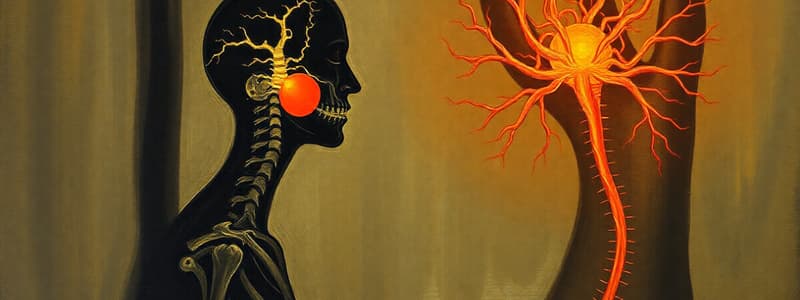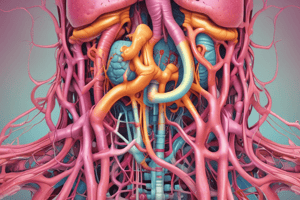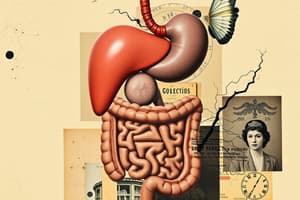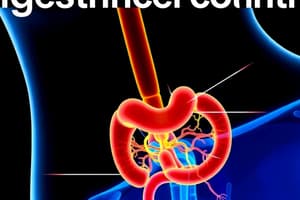Podcast
Questions and Answers
What are the two main subdivisions of the autonomic nervous system?
What are the two main subdivisions of the autonomic nervous system?
- Cerebral cortex and spinal cord
- Sensory nervous system and motor nervous system
- Central nervous system and peripheral nervous system
- Sympathetic nervous system and parasympathetic nervous system (correct)
What is the enteric nervous system commonly abbreviated as?
What is the enteric nervous system commonly abbreviated as?
- ENS (correct)
- ANS
- CSN
- PNS
Which part of the autonomic nervous system is primarily responsible for the fight-or-flight response?
Which part of the autonomic nervous system is primarily responsible for the fight-or-flight response?
- Enteric nervous system
- Parasympathetic nervous system
- Somatic nervous system
- Sympathetic nervous system (correct)
Which statement about the parasympathetic nervous system is accurate?
Which statement about the parasympathetic nervous system is accurate?
What is a primary function of the enteric nervous system?
What is a primary function of the enteric nervous system?
What is the primary effect of norepinephrine (NE) secretion on gastrointestinal (GIT) smooth muscle?
What is the primary effect of norepinephrine (NE) secretion on gastrointestinal (GIT) smooth muscle?
Which of the following is NOT a consequence of norepinephrine's action on the GIT?
Which of the following is NOT a consequence of norepinephrine's action on the GIT?
What type of nerve fibers innervate the gut according to the content?
What type of nerve fibers innervate the gut according to the content?
What components make up the enteric nervous system (ENS)?
What components make up the enteric nervous system (ENS)?
What is the role of the parasympathetic nervous system in gastrointestinal motility?
What is the role of the parasympathetic nervous system in gastrointestinal motility?
In which part of the digestive system do these types of contraction primarily occur?
In which part of the digestive system do these types of contraction primarily occur?
What is a key characteristic of the voluntary stage of swallowing?
What is a key characteristic of the voluntary stage of swallowing?
Which of the following best describes the mechanics of the pharyngeal stage of swallowing?
Which of the following best describes the mechanics of the pharyngeal stage of swallowing?
What distinguishes primary peristalsis from secondary peristalsis?
What distinguishes primary peristalsis from secondary peristalsis?
Which of the following is NOT a function of the stomach?
Which of the following is NOT a function of the stomach?
What primarily triggers an increase in peristaltic activity after a meal?
What primarily triggers an increase in peristaltic activity after a meal?
Which hormone is primarily associated with increasing gastrointestinal motility during fasting?
Which hormone is primarily associated with increasing gastrointestinal motility during fasting?
What is the role of the gastroileal reflex in gastrointestinal motility?
What is the role of the gastroileal reflex in gastrointestinal motility?
How does motilin affect gastric and intestinal motility?
How does motilin affect gastric and intestinal motility?
Which of the following hormones inhibits intestinal motility?
Which of the following hormones inhibits intestinal motility?
What initiates the voluntary stage of swallowing?
What initiates the voluntary stage of swallowing?
What happens to swallowing after the pharyngeal stage begins?
What happens to swallowing after the pharyngeal stage begins?
Which type of contractions occur at the sphincters during digestion?
Which type of contractions occur at the sphincters during digestion?
What is the role of local intermittent constrictive contractions in the gastrointestinal tract?
What is the role of local intermittent constrictive contractions in the gastrointestinal tract?
Which statement best describes the voluntary stage of swallowing?
Which statement best describes the voluntary stage of swallowing?
What triggers a constrictive ring in the colon during mass movements?
What triggers a constrictive ring in the colon during mass movements?
How frequently do mass movements occur in the colon?
How frequently do mass movements occur in the colon?
What happens to the portion of the colon distal to the constrictive ring during mass movements?
What happens to the portion of the colon distal to the constrictive ring during mass movements?
What reflexes facilitate mass movements in the colon?
What reflexes facilitate mass movements in the colon?
What condition is associated with persistent mass movements in the colon?
What condition is associated with persistent mass movements in the colon?
Flashcards
Where do contractions occur in the digestive system?
Where do contractions occur in the digestive system?
Contractions occur in the esophagus and stomach.
What happens during the Voluntary stage of Swallowing?
What happens during the Voluntary stage of Swallowing?
The voluntary stage is when the tongue moves food towards the back of the mouth, initiating the swallowing reflex.
Describe the Pharyngeal Stage of Swallowing.
Describe the Pharyngeal Stage of Swallowing.
During the pharyngeal stage, the soft palate elevates to block the nasal cavity, the epiglottis closes to protect the airway, and the pharynx contracts, propelling food toward the esophagus.
What is the difference between Primary and Secondary Peristalsis?
What is the difference between Primary and Secondary Peristalsis?
Signup and view all the flashcards
What are the functions of the stomach?
What are the functions of the stomach?
Signup and view all the flashcards
Sympathetic Nervous System (SNS)
Sympathetic Nervous System (SNS)
Signup and view all the flashcards
Parasympathetic Nervous System (PNS)
Parasympathetic Nervous System (PNS)
Signup and view all the flashcards
Enteric Nervous System (ENS)
Enteric Nervous System (ENS)
Signup and view all the flashcards
Nervous System Divisions
Nervous System Divisions
Signup and view all the flashcards
Peripheral Nervous System (PNS) Divisions
Peripheral Nervous System (PNS) Divisions
Signup and view all the flashcards
Peristalsis
Peristalsis
Signup and view all the flashcards
Chyme movement through the ileocecal valve
Chyme movement through the ileocecal valve
Signup and view all the flashcards
Increased peristaltic activity
Increased peristaltic activity
Signup and view all the flashcards
Gastroenteric reflex
Gastroenteric reflex
Signup and view all the flashcards
Motilin
Motilin
Signup and view all the flashcards
Norepinephrine's Effect on the GIT
Norepinephrine's Effect on the GIT
Signup and view all the flashcards
What is the Enteric Nervous System?
What is the Enteric Nervous System?
Signup and view all the flashcards
What is the Myenteric Plexus?
What is the Myenteric Plexus?
Signup and view all the flashcards
What do sensory nerve endings do in the gut?
What do sensory nerve endings do in the gut?
Signup and view all the flashcards
How does the parasympathetic nervous system affect digestion?
How does the parasympathetic nervous system affect digestion?
Signup and view all the flashcards
Swallowing (Deglutition)
Swallowing (Deglutition)
Signup and view all the flashcards
Voluntary Stage of Swallowing
Voluntary Stage of Swallowing
Signup and view all the flashcards
Pharyngeal Stage of Swallowing
Pharyngeal Stage of Swallowing
Signup and view all the flashcards
Esophageal Stage of Swallowing
Esophageal Stage of Swallowing
Signup and view all the flashcards
Peristaltic Contractions
Peristaltic Contractions
Signup and view all the flashcards
Mass Movement
Mass Movement
Signup and view all the flashcards
Gastrocolic Reflex
Gastrocolic Reflex
Signup and view all the flashcards
Duodenocolic Reflex
Duodenocolic Reflex
Signup and view all the flashcards
Autonomic Nervous System and Mass Movements
Autonomic Nervous System and Mass Movements
Signup and view all the flashcards
Irritations and Mass Movements
Irritations and Mass Movements
Signup and view all the flashcards
Study Notes
Gastrointestinal Tract (GIT) Motility
- The GIT's motility is controlled by the Central Nervous System (CNS), Autonomic Nervous System (ANS), and the Enteric Nervous System (ENS)
- Phasic and tonic contractions are two types of contractions with different functions
- Phasic contractions occur rhythmically and are determined by slow waves, followed by relaxation
- Occur in the esophagus and small intestine
- Tonic contractions are maintained contractions, not associated with slow waves
- Occur in sphincters
- Intensity can increase or decrease
Learning Objectives
- Describe the composition of the CNS, ANS & ENS, and their relationship.
- Differentiate between phasic and tonic contractions in the GIT, and where they occur.
- Explain the voluntary and pharyngeal stages of swallowing.
- Compare and contrast primary and secondary peristaltic movements.
- Detail the functions of the stomach, including the causes of retropulsion and pyloric spasm.
- Explain the motility of the small intestine, including segmentation and peristalsis, and the roles of hormones in regulating motility.
- Describe the main functions of the large intestine, and how mass movements occur.
- Discuss the roles of hormones in regulating gastrointestinal motility.
Neural Control of GIT Functions
- The ENS, a component of the intrinsic system, consists of two plexuses:
- The myenteric plexus (Auerbach's plexus) which controls GIT movements.
- The submucosal plexus (Meissner's plexus) which controls GIT secretions and local blood flow.
- The extrinsic component, the ANS, influences GIT function:
- The parasympathetic nervous system increases motility and secretions (stimulates GIT functions)
- The sympathetic nervous system inhibits motility and secretions.
- The ENS functions independently.
Sensory Nerve Endings
- Many sensory nerve fibers in the gut respond to stimuli like irritation, distension, and chemicals
- These stimuli may cause excitation or inhibition of intestinal movements or secretions.
Swallowing (Deglutition)
- Swallowing involves three stages:
- Voluntary (mouth)
- Pharyngeal
- Esophageal
- The voluntary stage involves the tongue squeezing food posteriorly toward the pharynx.
- The pharyngeal stage involves the stimulation of swallowing receptor areas, resulting in impulses traveling to the brain stem swallowing center.
- The palate, palatopharyngeal folds and epiglottis are involved to prevent food from entering the nasal cavities, trachea and lungs.
- The esophageal stage involves primary peristalsis initiated in the pharynx, to propel the food to the stomach via the esophagus.
Esophageal Stage
- Primary peristalsis is a continuation of the pharyngeal stage peristaltic wave that moves food from the pharynx to the stomach.
- Secondary peristalsis occurs in response to food stuck in the esophagus
- The process continues until all food that entered the esophagus is emptied into the stomach
Motor Functions of the Stomach
- The stomach stores large quantities of food.
- Mixes the food with gastric secretions to form chyme.
- Empties chyme into the small intestine.
Retropulsion
- Weak peristaltic constrictor waves (mixing waves) in the stomach
- Constrictor waves in the mid-upper stomach that move towards the antrum
- Propel food under higher pressure towards the pylorus
Pylorus
- The pylorus opening is small and only a limited amount of antral contents is expelled per peristaltic wave.
- Peristaltic wave contracts the pyloric muscle which impedes contents from emptying into the duodenum (important in the mixing process).
Motility of the Small Intestine
- The small intestine utilizes mixing contractions (segmentations) and propulsive movements (peristalsis).
- Segmentation involves localized concentric contractions that mix chyme to increase its contact with digestive enzymes.
- Peristalsis propels chyme through the intestines.
- The gastro-enteric and gastro-ileal reflexes enhance peristaltic activity.
Hormones and Intestinal Motility
- Certain hormones increase intestinal motility, while others inhibit it.
- Gastrin, CCK, insulin, motilin, and serotonin increase intestinal motility
- Secretin, Glucagon inhibit intestinal motility.
Large Intestine
- Absorption of water and electrolytes from chyme into solid feces
- Storing fecal matter until expulsion.
- Mixing through haustrations, and
- Propulsive movements (mass movements).
Defecation
- The reflexes are transmitted by the autonomic nervous system.
- Irritation can initiate intense mass movements (e.g., in ulcerative colitis).
Pyloric Spasm
- Pyloric spasm is a condition where the pylorus becomes more constricted than normal.
- This leads to food staying in the stomach longer than normal, which increases stomach acidity
- This can cause vomiting and pain
Studying That Suits You
Use AI to generate personalized quizzes and flashcards to suit your learning preferences.




